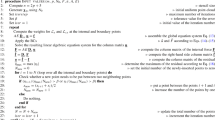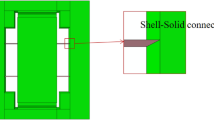Abstract
Recently, the radial point interpolation meshfree method has gained popularity owing to its advantages in large deformation and discontinuity problems, however, the accuracy of this method depends on many factors and their influences are not fully investigated yet. In this work, three main factors, i.e., the shape parameters, the influence domain size, and the nodal distribution, on the accuracy of the radial point interpolation method (RPIM) are systematically studied and conclusive results are obtained. First, the effect of shape parameters (R, q) of the multi-quadric basis function on the accuracy of RPIM is examined via global search. A new interpolation error index, closely related to the accuracy of RPIM, is proposed. The distribution of various error indexes on the R-q plane shows that shape parameters q ∈ [1.2, 1.8] and R ∈ [0, 1.5] can give good results for general 3-D analysis. This recommended range of shape parameters is examined by multiple benchmark examples in 3D solid mechanics. Second, through numerical experiments, an average of 30–40 nodes in the influence domain of a Gauss point is recommended for 3-D solid mechanics. Third, it is observed that the distribution of nodes has significant effect on the accuracy of RPIM although it has little effect on the accuracy of interpolation. Nodal distributions with better uniformity give better results. Furthermore, how the influence domain size and nodal distribution affect the selection of shape parameters and how the nodal distribution affects the choice of influence domain size are also discussed.
Similar content being viewed by others
References
BELYTSCHKO T, LU Y Y, GU L. Element-free Galerkin methods [J]. International Journal for Numerical Methods in Engineering, 1994, 37(2): 229–256.
LIU W K, JUN S, ZHANG Y F. Reproducing kernel particle methods [J]. International Journal for Numerical Methods in Fluids, 1995, 20(8/9): 1081–1106.
ATLURI S N, ZHU T. A new meshless local Petrov-Galerkin (MLPG) approach in computational mechanics [J]. Computational Mechanics, 1998, 22(2): 117–127.
LIU G R, GU Y T. A point interpolation method for two-dimensional solids [J]. International Journal for Numerical Methods in Engineering, 2001, 50(4): 937–951.
CHEN W. New RBF collocation methods and kernel RBF with applications [M]// GRIBEL M, SCHWEITZER M A, Eds. Meshfree Methods for Partial Differential Equations. Vol. 1, Springer Verlag, 2000.
CHEN W, FU Z J. Boundary particle method for inverse Cauchy problems of inhomogeneous Helmholtz equations [J]. Journal of Marine Science and Technology, 2009, 17(3): 157–163.
XIE H, NOGAMI T, WANG J G. A radial boundary node method for two-dimensional elastic analysis [J]. Engineering Analysis with Boundary Elements, 2003, 27: 853–862.
WANG J G, LIU G R. A point interpolation meshless method based on radial basis functions [J]. International Journal for Numerical Methods in Engineering, 2002, 54(11): 1623–1648.
LIU G R, GU Y T. A matrix triangularization algorithm for the polynomial point interpolation method [J]. Computer Methods in Applied Mechanics and Engineering, 2003, 192(19): 2269–2295.
LIU G R, ZHANG G Y, GU Y T, WANG Y Y. A meshfree radial point interpolation method (RPIM) for three-dimensional solids [J]. Computational Mechanics, 2005, 36(6): 421–430.
WANG J G, LIU G R, WU Y G. A point interpolation method for simulating dissipation process of consolidation [J]. Computer Methods in Applied Mechanics and Engineering, 2001, 190(45): 907–5922.
WANG J G, LIU G R, LIN P. Numerical analysis of Biot’s consolidation process by radial point interpolation method [J]. International Journal of Solids and Structures, 2002, 39(6): 1557–1573.
WANG J G, ZHANG B, NOGAMI T. Wave-induced seabed response analysis by radial point interpolation meshless method [J]. Ocean Engineering, 2004, 31(1): 21–42.
WANG J G, LIU G R. On the optimal shape parameters of radial basis functions used for 2-D meshless methods [J]. Computer Methods in Applied Mechanics and Engineering, 2002, 191(23/24): 2611–2630.
LIU G R, GU Y T. An introduction to meshfree methods and their programming [M]. Dordrecht: Springer, 2005.
BUHMANN M D. Radial basis functions: Theory and implementations [M]. Cambridge: Cambridge University Press, 2003: 57–73.
WENDLAND H. Scattered data approximation[M]. Cambridge: Cambridge University Press, 2005: 101–125.
HARDY R L. Multiquadric equations of topography and other irregular surfaces [J]. J Geophys Res, 1971, 76(8): 1905–1915.
HARDY R L. Theory and applications of multiquadric-biharmonic method: 20 Years of discovery 1968–1988 [J]. Computers & Mathematics with Applications, 1990, 19(88): 163–208.
FRANKE R. Scatter data interpolation: Test of some methods [J]. Mathematics of Computation, 1982, 38(157): 181–200.
RIPPA S. An algorithm for selecting a good value for the parameter c in radial basis function interpolation [J]. Advances in Computational Mathematics, 1999, 11(2): 193–210.
FORNBERG B, ZUEV J. The Runge phenomenon and spatially variable shape parameters in RBF interpolation [J]. Computers & Mathematics with Applications, 2007, 54(3): 379–398.
SARRA S A, STURGILL D. A random variable shape parameter strategy for radial basis function approximation methods [J]. Engineering Analysis with Boundary Elements, 2009, 33(11): 1239–1245.
XIAO J R, McCARTHY M A. A local Heaviside weighted meshless method for two-dimensional solids using radial basis functions [J]. Computational Mechanics, 2003, 31(3): 301–315.
LI L, ZHU J, ZHANG S. A hybrid radial boundary node method based on radial basis point interpolation [J]. Engineering Analysis with Boundary Elements, 2009, 33(11): 1273–1283.
XIAO J R, GAMA B A, GILLESPIE J W, KANSA E. Meshless solutions of 2D contact problems by subdomain variational inequality and MLPG method with radial basis functions [J]. Engineering Analysis with Boundary Elements. 2005, 29(2): 95–106.
DINIS L M J S, JORGE R M N, BELINHA J. Analysis of 3D solids using the natural neighbour radial point interpolation method [J]. Computer Methods in Applied Mechanics and Engineering, 2007, 196(13/16): 2009–2028.
QIAN Wei-chang. Elastic mechanics [M]. Beijing: Science Press, 1956. (in Chinese)
TIMOSHENKO S P, GOODIER J N. Theory of elasticity [M]. New York: McGraw-Hill, 1970.
LIU G R, GU Y T. Boundary meshfree methods based on the boundary point interpolation methods [J]. Engineering Analysis with Boundary Elements, 2004, 28(5): 475–487.
DU Q, FABER V, GUNZBURGER M. Centroidal Voronoi tessellations: Applications and algorithms [J]. SIAM Review, 1999, 41(4): 637–676.
LIU Yan, JIE Yu-xin. Simulated-annealing-based algorithm for generating point sets for meshfree methods [J]. Journal of Tsinghua University: Science and Technology, 2008, 48(6): 959–962. (in Chinese)
Author information
Authors and Affiliations
Corresponding author
Additional information
Foundation item: Project(2010CB732103) supported by the National Basic Research Program of China; Project(51179092) supported by the National Natural Science Foundation of China; Project(2012-KY-02) supported by the State Key Laboratory of Hydroscience and Engineering, China
Rights and permissions
About this article
Cite this article
Peng, C., Yuan, Hn., Zhang, By. et al. Factors affecting accuracy of radial point interpolation meshfree method for 3-D solid mechanics. J. Cent. South Univ. 20, 3229–3246 (2013). https://doi.org/10.1007/s11771-013-1847-6
Received:
Accepted:
Published:
Issue Date:
DOI: https://doi.org/10.1007/s11771-013-1847-6




